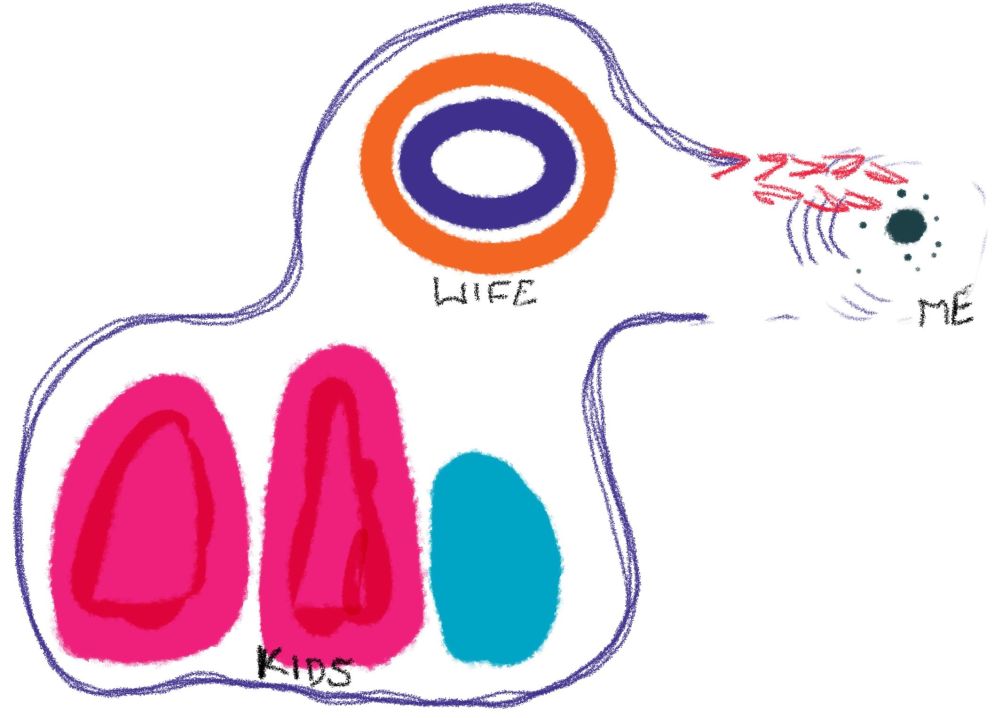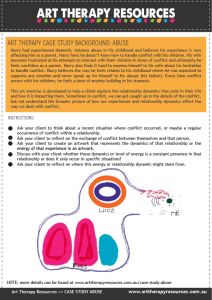THIS POST INCLUDES:
- Art Therapy and Abuse
- About the Client
- Current Client Issues
- Art Therapy Exercise
- Client Insight and Outcomes
- Disclaimer
- FREE DOWNLOAD Art Therapy Exercise
ART THERAPY AND ABUSE
Art therapy can help those who have suffered abuse of various kinds.
TYPES OF ABUSE
The most common types of abuse fall under the following categories:
- Bullying
- Sexual abuse
- Domestic violence /IPV – direct and witnessing
Within each category, people can experience many forms of abuse. For example, children can experience bullying at school, and adults can experience bullying at work. Abuse may also take the form of physical assault or psychological abuse or verbal abuse.
In all situations, there exists an imbalance of power over someone. The power is used to suppress and oppress another person which leads to traumatic and often life altering experiences that have damaging effects over a long period of time.
In some situations of abuse, the circumstances can render the victim in a helpless state where they are unable to safely seek help to escape the abuse and ultimately begin a process of recovery.
For children who are raised in an abusive family dynamic, they can often experience multiple traumas throughout their lives which means recovery from abuse needs to address multiple aspects of their development including life skills, organisation tasks, verbal and physical development, and interpersonal relationship skills.
EFFECTS OF ABUSE
The most common effects that occur as a result of abuse is the experience of shame and being silenced. These feelings are most often internalized, however, there also exists many behaviours that occur that can be externalized.
Research has shown that there is a tendency for females to internalize their trauma through repressing emotions. There is a tendency for males to externalize their trauma and through behaviours that mimic aggression.
For children who experience abuse early in life, these experiences can contribute to how the person views themselves and how they express emotion. Specifically, they may have difficulty expressing emotions, managing negative emotions, or developing strategies to identify emotions in themselves and others.
Abuse can also affect how the person interacts with others and can often manifest through:
- Distrust and suspicion of others
- Difficulty with attachment
- Inability to develop boundaries
- Difficulty extending empathy to others
- Inability to view themselves as deserving of love or good experiences
HOW ART THERAPY CAN HELP WITH ABUSE
People who experience abuse have often been threatened to be silent about their abuse. While therapy is not an extension of that threat, the threat itself becomes ingrained in the individual’s belief system. Even though the individual is in a safe space in a therapeutic environment, this threat of silence is present in all situations.
Expression through art helps the individual express their emotions connected with the abuse, yet not require them to verbally reveal the details of the abuse. This can be an important part of the individual’s journey to find their voice.
In addition to silence, shame is another overwhelming aspect of abuse that affects an individual’s ability to disclose their experiences in therapy. The feelings of shame can make it unbearable for some people to speak about their trauma. They may feel the details are too disgusting to share, or they may feel they were complicit in their abuse. They may feel guilty for not taking action on previous abuse.
All of these experiences can make it difficult for people to actively reveal the details of their abuse. Art therapy can provide a safe space that does not require discussion of explicit or painful details. Art therapy can help us reveal the innermost secrets that we hold.
Some of the most important areas where art therapy can help people who have experienced abuse include:
- diffusing negative thoughts
- redirecting
- reframing
- self-soothing
- emotional expression
- emotional regulation
- coping with overwhelming emotions
- explore personal value
- explore resilience
Imagery is an important aspect of abuse. Individuals are often plagued by recurring memories of events when they were abused. Art therapy has a role in reclaiming the imagery that individuals can use to focus on and use as a vehicle to redirect their attention.
This can help the individual feel they have the ability to redirect their thoughts and hold on to new imagery that will support them through the healing process.
ABOUT THE CLIENT
- Name: Harry
- Age: 36
CURRENT CLIENT ISSUES
Harry had experienced domestic violence abuse in his childhood and believes his experience is now affecting him as a parent. Harry feels he doesn’t know how to handle conflict with his children. His wife becomes frustrated at his attempts to interact with their children in times of conflict and ultimately he feels worthless as a parent.
Harry also finds it hard to express himself to his wife about his hesitation to handle conflict. Harry believes the way he feels relates to his childhood where he was expected to suppress any emotion and never speak up for himself to his abuser (his father). Every time conflict occurs with his children, he feels a knot of anxiety building in his stomach.
ART THERAPY EXERCISE
This art exercise is developed to help a client explore the relationship dynamics that exist in their life and how it is impacting them. Sometimes in conflict, we can get caught up in the details of the conflict, but not understand the broader picture of how our experiences and relationship dynamics affect the way we deal with conflict.
INSTRUCTIONS:
- Ask your client to think about a recent situation where conflict occurred, or maybe a regular occurrence of conflict within a relationship.
- Ask your client to reflect on the exchange of conflict between themselves and that person.
- Ask your client to create an artwork that represents the dynamics of that relationship or the energy of that experience in an artwork.
- Discuss with your client whether these dynamics or level of energy is a constant presence in that relationship or does it only occur in specific situations?
- Ask your client to reflect on where this energy or relationship dynamic might stem from.
CLIENT INSIGHT AND OUTCOMES
Harry mentioned he had thought about the exchanges between his wife and children before and could see how his background with abuse impacts the exchanges.
Harry noted that identifying the type of energy that surrounds how he interacts with his wife and children in times of conflict was a reflection of the energy he found existed in his own family as a kid.
Harry noted that focusing his attention on how the exchanges were between himself and his wife and children made him focus more on HOW they interacted instead of the specific content of each incident of conflict. Harry recognizes that the content of the conflict is often not the problem, but instead of how everyone in the family interacts.

DISCLAIMER
This case study represents a snapshot of the client’s progress in treatment. The exercise in this article could be used as written or as a guide for new and original tasks developed by the Art Therapist. Responsibility for treatment resides with the individual therapist who understands their clients specific needs. The art therapy exercise should not be viewed as a pre-defined directive on how to treat a client that presents with a specific range of problems.This art therapy exercise will help build a database of knowledge to draw upon when helping your client. Art Therapy is associated with psychotherapy techniques, however each therapist often approaches therapy with their own foundation of psychological interventions, whether it be psychotherapy, CBT, DBT or other methods.
FREE DOWNLOAD: Art Therapy Exercise
Download the FREE Art Therapy Exercise based on the above Case Study. The free download includes instructions for the art therapy exercise, along with an example of the art therapy exercise.

BUILD YOUR ART THERAPY REFERENCE MATERIALS:
Pin this image to your Pinterest board.

SHARE KNOWLEDGE & PASS IT ON:
If you’ve enjoyed this post, please share it on Facebook, Twitter, Pinterest. Thank you!
